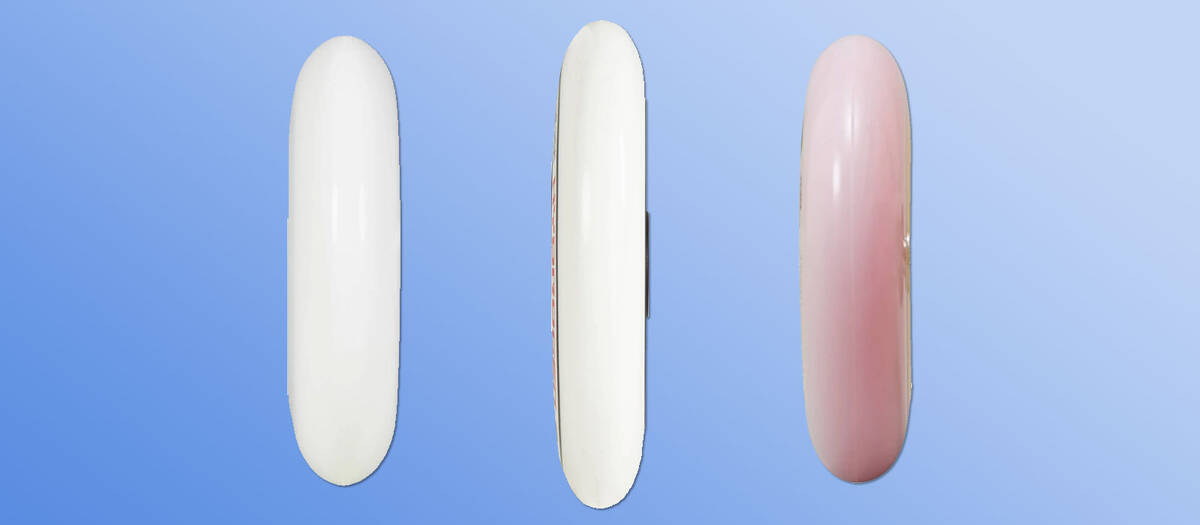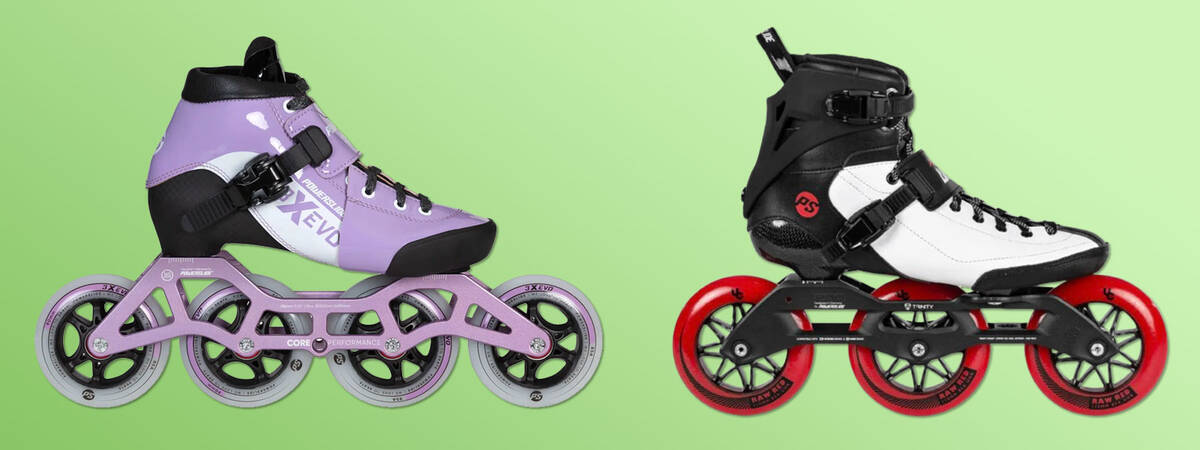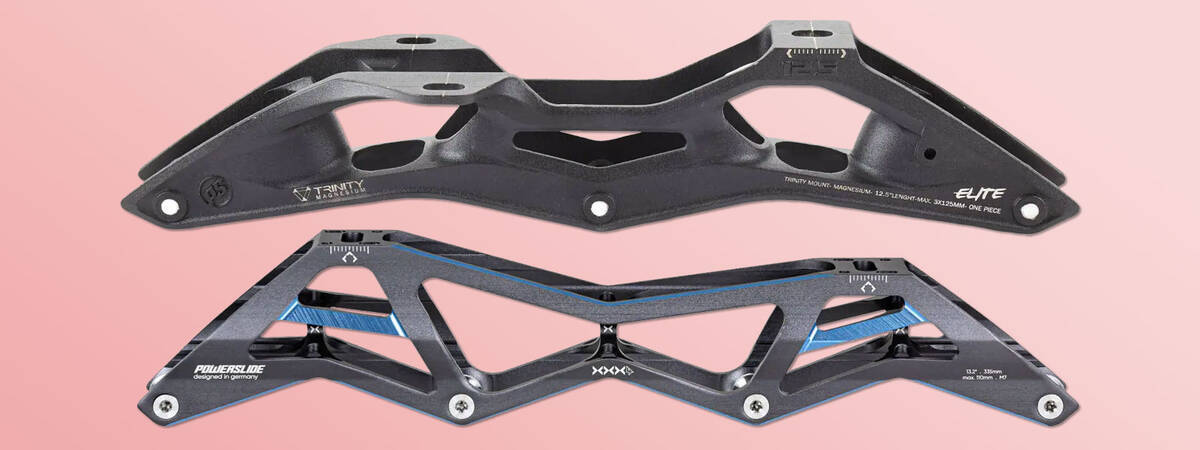Buying Speed Skates
This is our speed skates buyer’s guide, covering wheel size, bearings, boots, and frames. Buying the best speed skates is all about performance. Whether you are a beginner or a pro, the central aspect of speed skates is speed, and in this guide you'll learn what makes speed skates roll fast.
Your preferences will naturally depend on the circumstances under which you skate and the type of speed skating you pursue, but don't worry, we'll shed some light on the questions you may have about choosing speed skates.
Wheels for Speed Skates

To achieve the fastest speeds, you need inline skates with large wheels. Let’s look at the basics of wheels for speed skates. The two most important factors are wheel size and wheel hardness, but wheel hubs and wheel profile also affect your speed skates' performance.
Wheel Size for Speed Skating
Wheels for speed skating are usually larger than wheels for recreational skating. Here are some key pointers for choosing speed skate wheel sizes:
- 90 mm: Recommended speed skate wheel size for beginners and children. The lower center of gravity provides easier control.
- 100 mm and 110 mm: Suitable for casual speed skaters and competitors, offering higher speeds.
- 125 mm: Used by marathon skaters to achieve the highest speeds and cover long distances. 125 mm wheels are used on 3-wheel setups
Theoretically (and most often in practice), bigger wheels are faster. As a beginner, you might not have the technique for skating with 110 mm or 125 mm wheels, so you will likely be faster on smaller wheels. But provided that you have the skills to control them, you can reach higher speeds with bigger wheels.
Smaller wheels, on the other hand, accelerate faster. If you mainly sprint shorter distances, you should avoid 125 mm wheels, as you will need more time to reach the high speeds they are capable of.
Note: 125 mm wheels are not allowed for indoor races or track races.
Wheel Hardness for Speed Skating
Wheels for speed skating are usually harder than those for recreational or fitness inline skates. The extra hardness makes the wheels faster because they create less friction with the surface. However, this also results in less grip and reduced absorption of vibrations.
When considering the wheel hardness of the speed skates you’re about to buy, think about the conditions in which you’ll be skating. Will you be skating outside on public roads, outdoor rinks, or indoor rinks?
- Harder wheels: Offer less grip, less absorption of vibrations, less friction, and higher speeds.
- Softer wheels: Provide more grip, more absorption of vibrations, more friction, and higher speeds.
If you’re skating on indoor rinks or very smooth surfaces, harder wheels are suitable. However, if you’re skating on rough and unpredictable roads, you should opt for softer wheels.
The typical wheel hardness of speed skates is a durometer of around 85 A.
Wheel Profile for Speed Skating

Speed skating wheels typically have a pointy or narrow profile. This creates a narrower contact point between the wheel and the surface, resulting in less friction and more speed.
As your wheels wear down, the point of contact between the wheels and the surface will increase. The center line of the wheels will also move out towards the sides. This is due to the sideward movement of your stride, and it is perfectly normal. Before this begins to have a negative effect on your skating, we recommend that you rotate the wheels.
How Many Wheels Do Speed Skates Have?

Inline speed skates usually have 3 or 4 wheels per skate. In the past, speed skates with 5 wheels per skate have also seen popularity, but today's speed skates have either 3 or 4 wheels.
- 3 wheels per skate: The shorter wheelbase makes the skates more maneuverable and agile. In addition, 3-wheel skates can accommodate larger wheels, which means less physical effort is required to maintain speed. Skates with 3 wheels demand more technical skill and are not recommended for absolute beginners.
- 4 wheels per skate: 4-wheel skates have a longer wheelbase, making the skates less maneuverable but more stable. Beginners should go for 4 wheels per skate.
In competitive speed skating, 3-wheel setups with 125 mm wheels are only seen in marathons. 4-wheel setups with 110 mm wheels are typical for competitive speed skating disciplines taking place indoors or on specialized outdoor tracks.
Inline Speed Skate Frames

Inline speed skate frames are responsible for holding the wheels. The speed skate frames determine some important aspects of your overall setup:
- 3-wheeled or 4-wheeled frame: The frame determines how many wheels you can mount on your skates.
- Wheelbase: The distance between the center of the front and back wheel.
- Wheel diameter: What are the largest wheels that can be mounted on the frame?
Proper inline speed skate frames are lightweight and typically made of aluminum or carbon fiber.
- Carbon fiber speed skate frames are stiffer and lighter than aluminum frames, and they are often praised for offering superior power transmission.
- Aluminum speed skate frames are more durable and forgiving than carbon frames.
Inline Speed Skate Frame Alignment
The concept of speed skate frame alignment is relevant for all speed skaters, especially those focused on performance. It's not just something to consider when upgrading your frames, but also when purchasing complete speed skates. You may develop personal preferences or need a different frame alignment than the one provided out of the box.
Adjusting speed skate frames is all about finding the optimal balance point based on your physiology. If you have trouble keeping your ankles straight (if you fall to the inside of the skate), you may need to adjust the lateral position of the frame slightly.
Adjusting speed skate frames is a matter of mounting them in the middle of the boots both laterally and longitudinally.
Lateral adjustment of speed skate frames:
- The front wheel should be aligned with the point where your big toe and second toe split.
- The rear wheel should be aligned with the center of the heel cup of the boot.
Longitudinal adjustment of speed skate frames:
- The boot should be centered in the frame (the distance from the tip of the boot to the tip of the frame should be equal to the distance from the back of the boot to the back of the frame).
Discover our full selection here:
Inline Speed Skate Boots

The most important factor to consider in inline speed skate boots is maximizing power transfer. This means you need a stiff, snug boot that offers no room for your feet to move around inside.
Typically, speed skate boots come without liners. While liners provide comfort, they can compromise direct power transfer, which is why they are often sacrificed in professional speed skating. However, many inline skates designed for speed still offer comfort features such as higher ankle support or liners, making them a great option for inline marathons.
Heat-Moldable Speed Skate Boots
Many advanced speed skates have heat-moldable boots, meaning that the boot becomes moldable when subjected to heat. Heat-molding your boots can help you prevent pressure points, discomfort, and blisters by molding the boot perfectly to your individual foot shape. A properly heat-molded boot has a snug and customized fit that improves control and power transfer, which is especially desirable for the performance-oriented speed skater.
When heat-molding your boots, please follow the instructions given by the manufacturer for your specific model.
Speed Skate Bearings
When buying a pair of speed skates, it can be a good idea to look at the bearings, but in general, the bearings that are installed in a pair of speed skates should not dictate your choice. If you buy a decent-quality speed skate, it will come with decent-quality bearings.
Most bearings are rated using the ABEC scale, where a higher ABEC rating indicates greater precision in manufacturing. While the ABEC rating does not directly measure how fast the bearings can roll, it does reflect the tolerance for error in their construction. Consequently, bearings with a lower ABEC rating may not offer as smooth a rollout as those with a higher ABEC rating.
You may also encounter bearings with an ILQ rating, which stands for InLine Qualified. Don't worry - these bearings are high-quality and will perform excellently!
When purchasing bearings for speed skating, it is best to look at brand recommendations and user feedback rather than specs. Many experienced speed skaters say that you should focus on the durability of a particular bearing rather than ABEC-rating.
Another important factor in speed skate bearings (and other roller sports) is maintenance and lubrication. You should always keep an eye on the condition of your bearings, and remember that they will last longer if you clean and lubricate them before they go bad. Otherwise, you will have to buy new bearings.
